
Greek Food and Drink
Greek food is delicious
Greek cuisine is based on the "Mediterranean triad" of wheat, olive oil, and wine, and was a forerunner of Western cuisine. The cuisine has a long history, like the country itself. Archestratos wrote the world's first food manual, in 320 BC. It took the form of a long and humorous didactic poem titled Hedypatheia, meaning Life of Luxury, and it advised the reader on where to find the best food in the Mediterranean world. It parodies the writing of earlier writers who had put meaningful sayings into verse in order to aid in their memorization, thereby giving Archestratos the reputation of being the Hesiod or Theognis of gluttons. The article Feasting with Archestratus describes the writer and his poem, along with other early Greek writers on food.
Meat was very rarely eaten, fish was far more common from ancient times through the Byzantine and Ottoman rules of the Greek peninsula and islands. Meat has only become more common within the past few years.
Olive oil is the oil used most often to prepare salads, marinades, and other dishes. Eggplant (or aubergine) and zucchini (or courgette) are commonly used, along with many potatoes, tomatoes, onions, cucumbers, and varied legumes and vegetables.
Yogurt and cheese are the primary dairy products. Feta or φέτα is the traditional favorite. It's made from sheep milk, with a mixture of up to 30% goats' milk allowed. It is aged in a solution of brine in an airtight chamber, giving it good stability and resistance to bacterial growth even in the hot climate of most of Greece. It is stored submerged in brine until it is ready to be eaten, otherwise it dries quickly. It was first described during the time of the Byzantine Empire, when it was most associated with the island of Crete and was called πρόσφατος or prósphatos, meaning "recent" or "fresh".
An Italian traveler described its storage in brine in 1494. The cheese came to be called φέτα or feta in the 1600s, based on the Italian word for "slice", fetta.
Greek colonists spread their cuisine through the Mediterranean, from Palestine in the east through the southern Italian peninsula to today's France and Spain in the west. Marseille, now a major city in France, was a Greek colony before the Roman Empire arose to become the main Mediterranean power.
Constantinople became the hub of the world spice trade and Greek cuisine was a beneficiary. Like other Mediterranean cuisines, Greek food features basil, thyme and fennel. There are other spices and herbs found more often in Greek recipes than Mediterranean dishes, especially oregano, mint, garlic, dill and bay leaves.
Greek Cuisine on the Mainland
Here is a typical lunch. Left to right, to eat: pita, horiatiki salata, and tzatziki. Behind that, to drink, water and retsina.
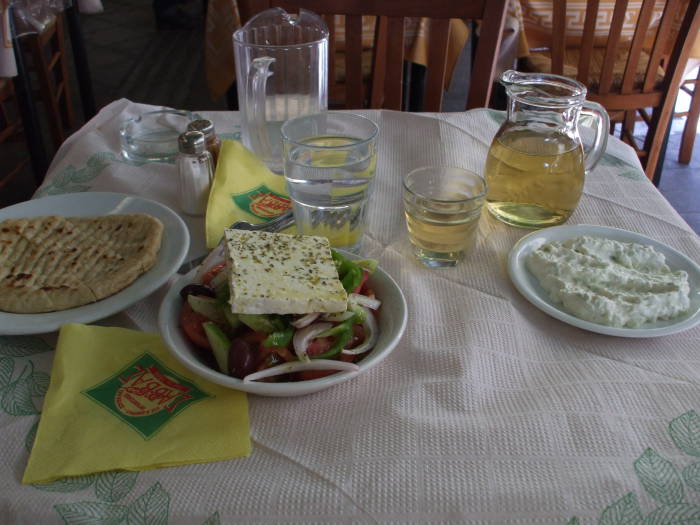
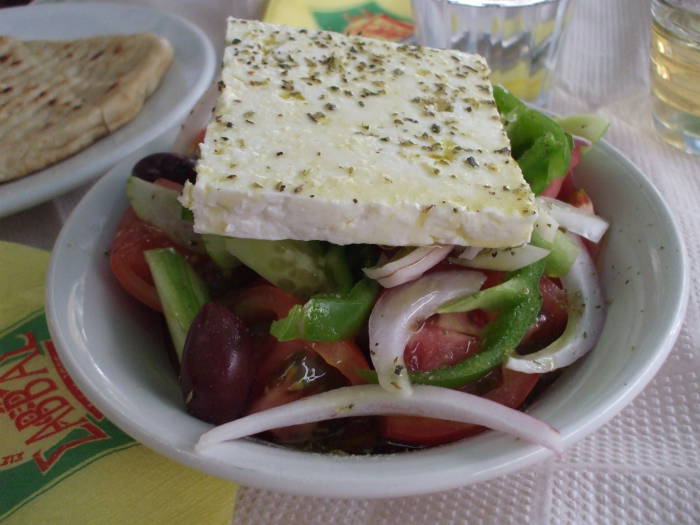
Χωριάτικη σαλάτα, or horiatiki salata, means "village salad", or "country salad", or "peasant salad", depending on who you ask. Outside of Greece we call it "Greek salad". The precise recipe varies from one taverna to the next.
Generally, though, it's tomatoes and cucumbers, onions, green bell peppers, olives, dressed with olive oil, and with a slab of φετα or feta cheese.
Τζατζίκι, or tzatziki, is made from yoghurt mixed with shredded cucumbers, garlic, and a relatively small amount of olive oil.
Its name is derived from a Greek spelling of the original Turkish name, cacık, pronounced as an English speaker would say jah-jook, with each "j" as in "judge".
Tzatziki can be an accompaniment for a gyros or souvlaki, or it can be spread on pita as part of a starting course.
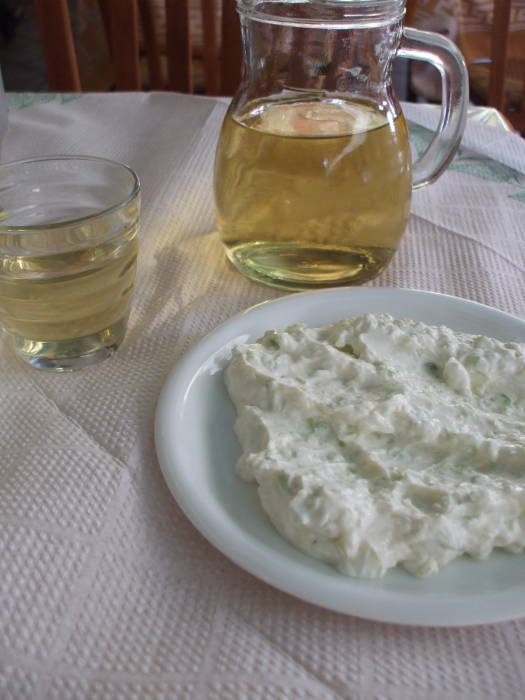
These pictures are from Σαββας, or Savvas, a good taverna in the Plaka district. It's just off Plateia Monastirakiou and near the Metro station entrances, at the east end of Mitropoleos.
In the last picture we're looking out from under Savvas' awning, across the narrow pedestrian passageway of Mitropoleos to Θανασις or Thanasis, a similarly good taverna.
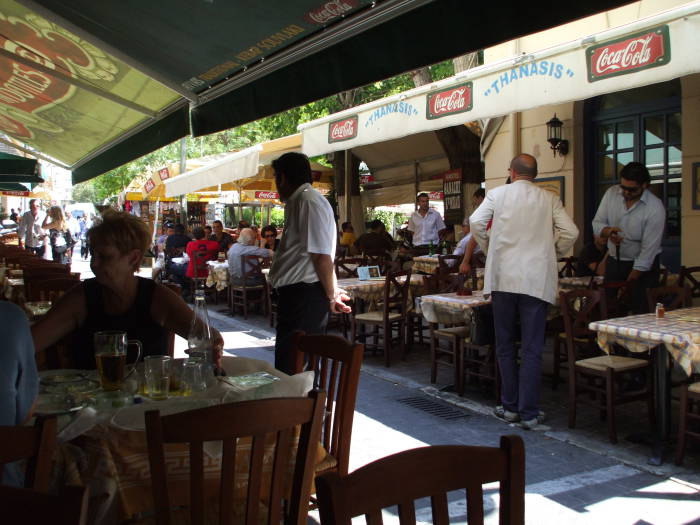
Ρετσίνα, or retsina, is a distinctive Greek white wine. An extremely distinctive form of wine, as it contains pine resin.
The practice of resinating wine is over 2000 years old. It was a side effect of sealing amphorae with the pitch or resin of Aleppo pine. The resin kept oxygen out of the amphorae and prevented the spoiling of the wine.
It hasn't really been needed since the introduction of sealed barrels in the 3rd Century AD, but the unusual flavor had become so popular in the Eastern Empire that they kept resinating the wine. Pliny the Elder wrote in his Natural History (14.124) recommending that resin be added to the fermenting must used to produce wine. He even specified that the resin should be from pines in mountainous areas, as they gave a better aroma than those from the lowlands.
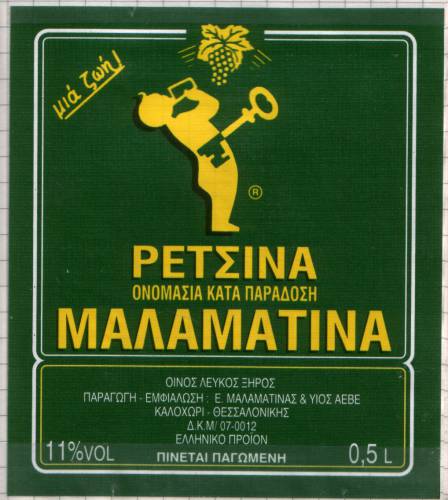

Μαλαματινα, or Malamatina, is a popular and cheap brand. If you ask for ρετσίνα χημα, that is, retsina hima, the term for the cheap house brand poured from the barrel, you might get literally that or you might get a bottle of Malamatina.
At right is a half-litre bottle of retsina at a snack stand across from the central public market in Athens.
Retsina is now produced in various areas throughout Greece, ranging as wide as Rhodes and Cyprus, but the style is most associated with regions around the Athens area: Attica, Boeotia, and Euboea.
The wine is produced much as usual, except that small pieces of Aleppo pine resin is added to the must during fermentation. An oily resin film forms on the liquid's surface. The solids and surface film are removed at racking time and the liquid is clarified.
"Retsina" is now a protected designation of origin in the European Union.
The entrance to the Student and Traveler's Inn is just past the first awning in this picture. The tables under the larger awning beyond that are one of several tavernas around Plateia Filomousou Eterias in the Plaka district northeast of the Acropolis.
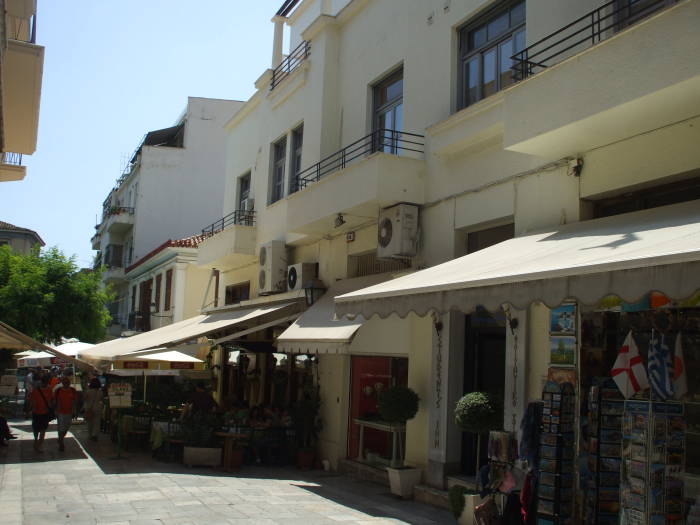
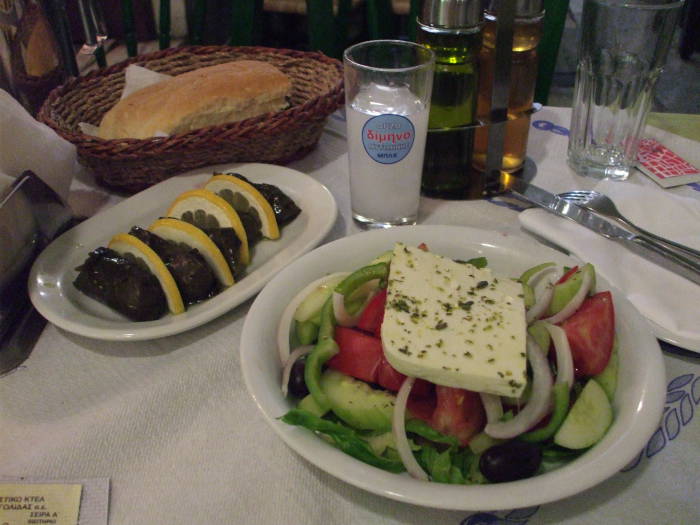
We have returned to that taverna in the evening. Another horiatiki salata, this time with dolmades, grape leaves stuffed with rice and herbs, seasoned with mint.
The white liquid is ούζο or ouzo, liquor with a strong anise flavor. Like absinthe and other similar liquors, it forms a louche or milky oil-in-water microemulsion.
You see, ouzo and those other anise based liquors contain a strongly hydrophobic essential oil dissolved in ethanol, which is miscible with water. When the concentration of the ethanol solvent is lowered by the addition of water, the oil comes out of solution and forms an emulsion.
Anise based aperitifs, strong both in taste and alcohol content, are popular around the Mediterranean. Arak in the Levant, oghi in Armenia, rakı in Turkey, ouzo in Cyprus and Greece, sambuca in Italy, pastis and absinthe in France, and patxaran in Spain.

This dinner is just a μεζε or meze plate, a selection of small starter items. A meze assortment is plenty to make a meal, and you get a wide variety of dishes. This is in a small restaurant with sidewalk tables in Nafplio.
Another meal starts, in Delphi this time. Horiatiki salata and a Mythos Greek beer.
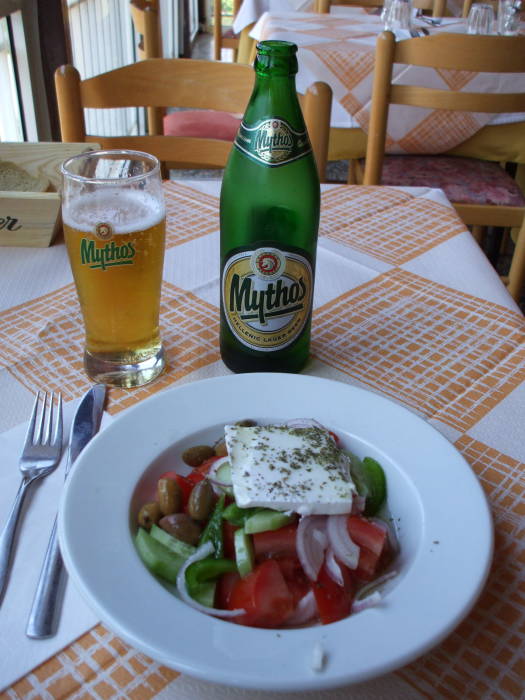
The meal concludes with a Greek style dessert, yoghurt with honey.
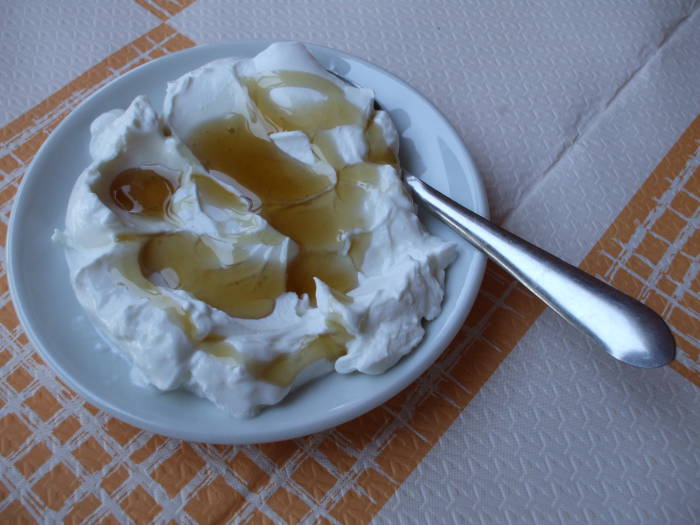
Greek breakfast appears to often be nothing but coffee and cigarettes. But places like these small cafes offer pastry.
These men may be at the tables for most if not all of the morning. They are in Thessaloniki, near the train station.
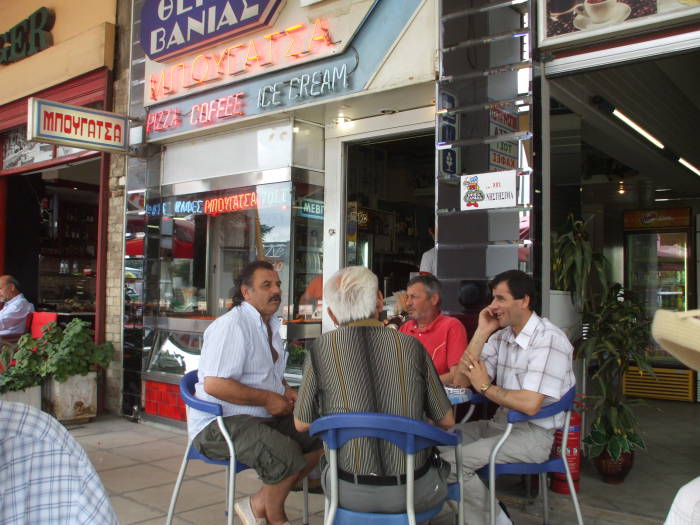
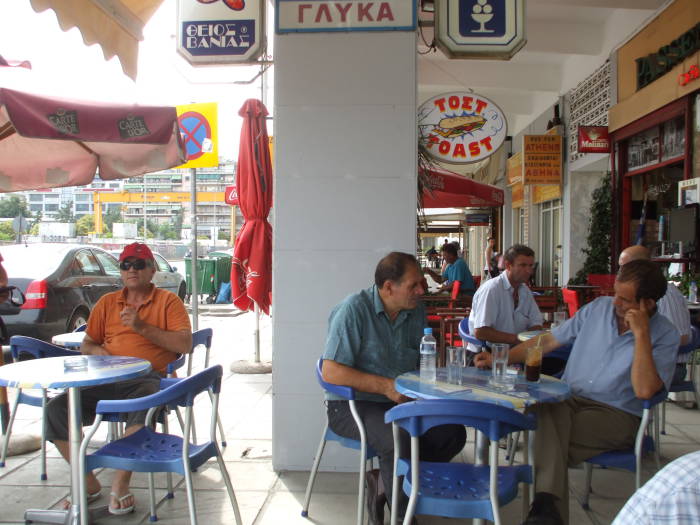
The same place also has toast, which is to say sandwiches with meat and cheese, pressed under a hot iron. It also offers a variety of light dishes and several flavors of ice cream.
A bigger meal in the evening might include a green bell pepper and a tomato stuffed with rice, along with roasted potato slices.
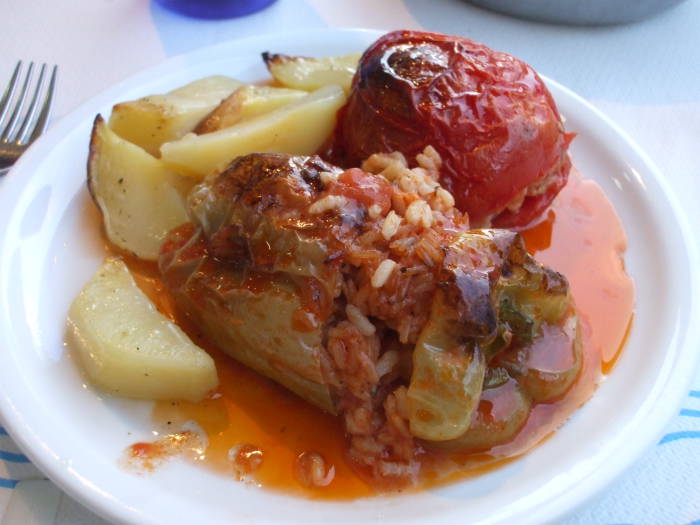
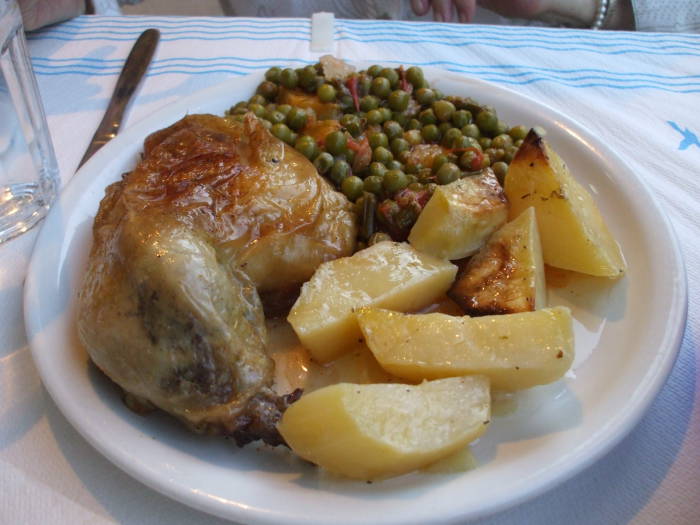
Or, roasted chicken, peas, and potatoes.
Generally speaking, Greek food is good. More importantly to the traveller, it is easy to find good Greek food. You don't have to search all over to find a place with good food.
Here is an excellent suggestion from Rick Steves:
Never ask someone, "What restaurant would you recommend?", or "Where is a good restaurant?"
That is usually interpreted as a request for the fanciest or most expensive local restaurant that they know of. They will almost certainly direct you to a place which they almost never visit, and which is not really popular at all with the majority of locals.
You risk getting the same type of answer if you ask where they like to eat, as that will often be misinterpreted as where they would like to eat, once, if they had an unlimited budget, or wanted to try something unusual.
A much better question is, "Where do you usually eat?"
Not where they speculate or dream that they might some day get a meal, but a place that is the common everyday local experience.
Greek Cuisine on the Islands
Mykonos and Santorini are the two islands most visited by foreign travelers and cruise ships, and for good reason.
Mykonos is marketed to Europe as the home of the best nightlife on the European continent. The top music producers and DJs come to its clubs and beach bars in the high season, July and August.
Mykonos has been a popular tourism destination for ages. The nearby island of Delos was a sacred island. It was famous as the birthplace of the twin deities Apollo and Artemis by the time that Homer was composing the Odyssey. Delos was a major religious center from 900 BCE through 100 CE. At times Delos was heavily populated, and at other times it was a religious sanctuary with no non-priestly permanent residents. Either way, Mykonos provided supplies and was a stage along the way to visit it.
With the rise of the concept of the Grand Tour among the educated from the mid to late 1600s through the 1840s, and even more so with the intellectual fashion of Philhellenism through the 1800s, Mykonos started to see visitors from western Europe, largely Britain. They came to see the nearby uninhabited island of Delos, which is the premier historical and mythological site in the Greek islands.
All these eccentric Britons started arriving at Mykonos, some insistently speaking the Koine Greek in which the New Testament was written, others speaking Homeric Greek. Imagine a modern visitor to London insisting on speaking the Anglo-Saxon of Beowulf.
They would buy their way to Mykonos on a fishing or cargo vessel and then ask the harbor master for a place to stay. There was nothing like a hotel at the time, but various elderly widows would have spare rooms that they might rent. This started the business of domatia, or rooms for rent, in the Greek islands.
These days it is much easier to get there and to find a place to stay, at least if you don't show up during high season. Use the below search engine to explore ferry schedules, and you can even buy your tickets in advance.
Check ferry schedules and buy tickets:
Here I am sitting at a cafe on the harbor waterfront in the Hora, the main town on the island of Mykonos. The main town on many Greek islands is simply called Χορα or Hora, which simply means "The Town".


"Greek coffee" is really Turkish coffee made by Greeks, although don't bring that up when you are in Greece. Just as with the Türkçe version, tell them when you order it if you want sugar.
The beans are ground to a fine powder, much of which ends up in the cup. Sip it slowly, letting the grounds settle, and don't try to finish the whole thing.
Unless, of course, you really want a gritty and highly caffeinated finish to your coffee!
Corner Crepes is a nice place along the main street through Fira, the main town on Santorini.

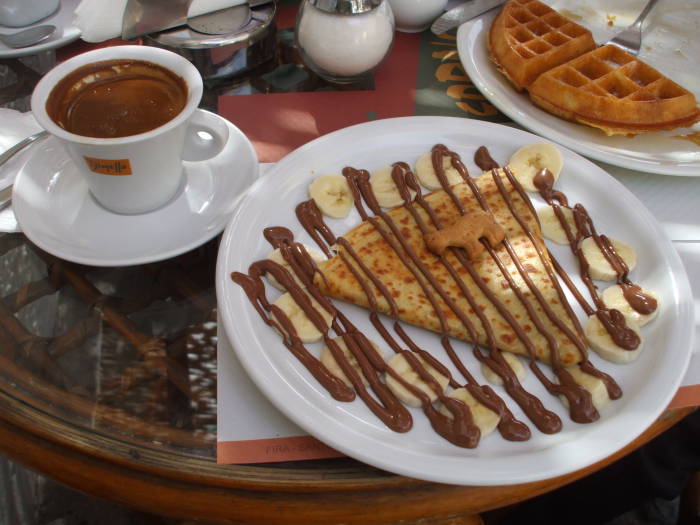
Crepes with banana slices, and chocolate syrup poured over all of it. Plus an animal cracker.
Next to it is a gritty cup of eye-opening Greek coffee.
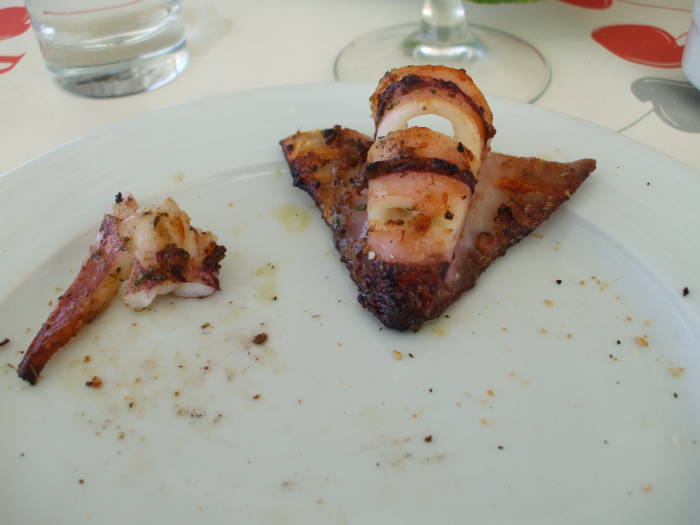
Moving on to lunch, we're back on Mykonos. We had started with a shared grilled cuttlefish. Cephalopods are common in the Aegean and on Greek tables.
Now the waiter has brought a dish of grilled fish.

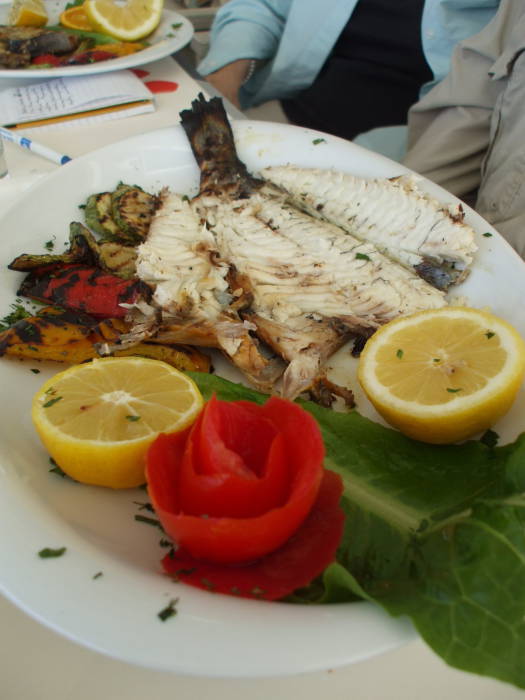
Next, some grilled fish steak accompanied by grilled vegetables in a taverna on Mykonos.
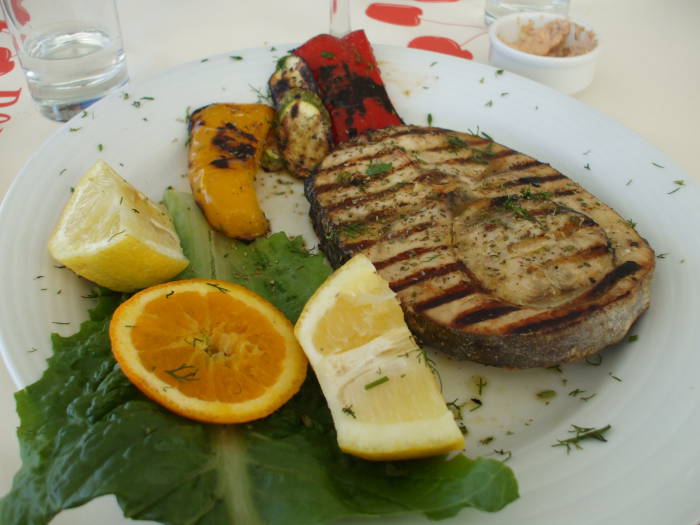
Now we have moved on to the island of Paros, famous throughout history as a source for translucent white marble marble. The Venus de Milo and other classic sculptures were made from Parian marble.
Paros is large enough that its main town and port is Parikia. It's not simply Χορα or Hora, meaning "Town".
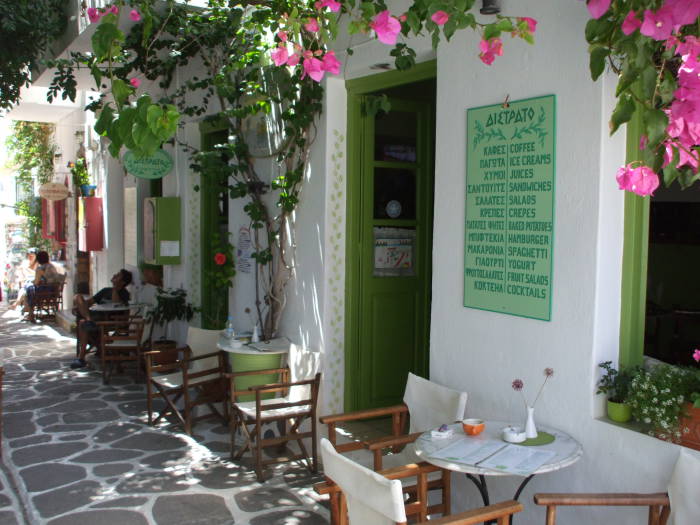
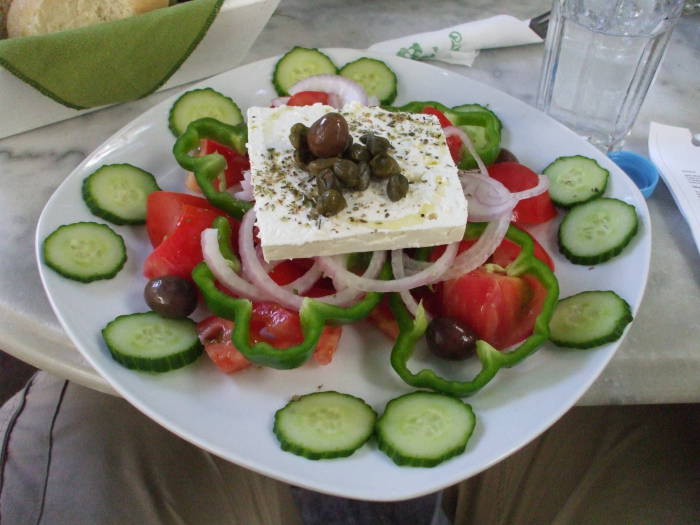
The cafe seen above is on one of the many back streets of Parikia, open to pedestrians only. The vines have grown across trellises and into a tree, making for a nicely shaded dining area.
Their version of horiatiki salata includes capers, seen here atop the feta.
This salad has bacon and avocado slices top a variety of greens.
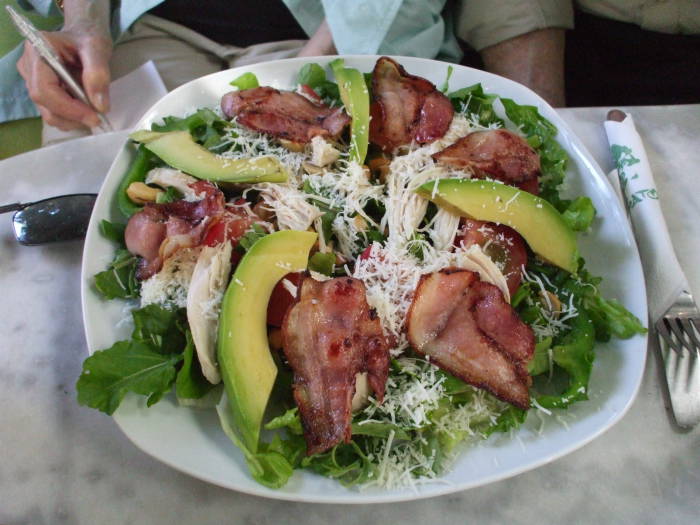

These two tavernas open onto the traffic circle at the port on Ios.
Ios has a reputation as the island of hedonism, nothing but crazy partying college students emulating Dionysius. Well, maybe in the heart of the high season. But if you're here from the middle of April until the middle of June, or from the second week of September through the end of October, it is very nice and just about as restful or as active as you care to search out.
This is the local Ios goat cheese, much softer than the typical crumbly feta, over a bed of greens and with olives and capers.
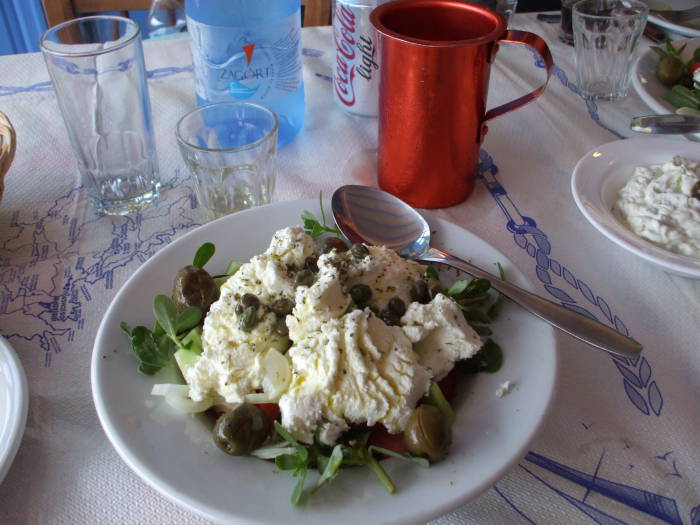
Notice the red anodized aluminum mug. That is how retsina is served in local places. Retsina hima, or retsina poured from a barrel (or keg). It is poured into these colorful aluminum pitchers, used as small pitchers. You don't drink directly out of the pitcher!
Well, maybe you do on Ios during the high season.
Anyway, pour it from the aluminum pitcher into the small faceted glass, seen here to the left of the pitcher.
The soft goat cheese is further away. Closer to the camera is a small dish of tzatziki.
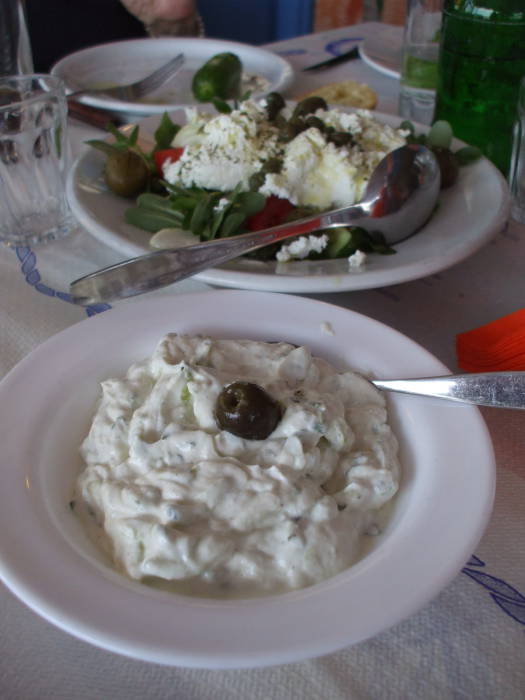
They have steamed zucchinis and then dressed them with olive oil.

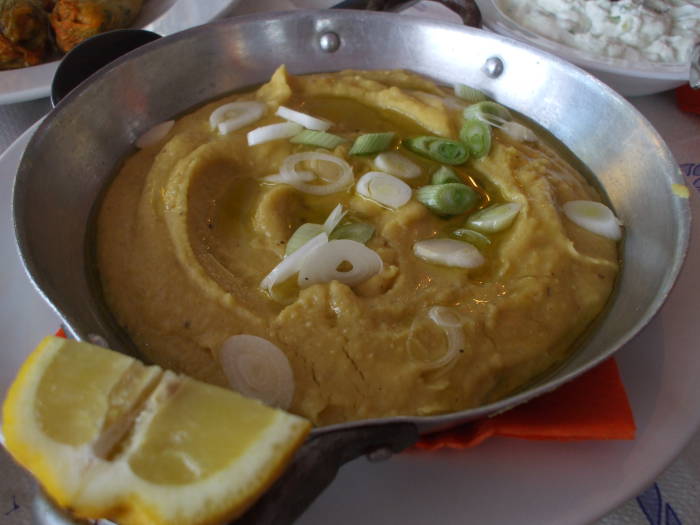
This pan holds a paste similar to hummus, except it is made from yellow lentils instead of chickpeas. It is spread on pieces of pita.
Here's that anodized aluminum retsina pitcher again. It's next to a dish of zucchini blossoms stuffed with rice and then fried.
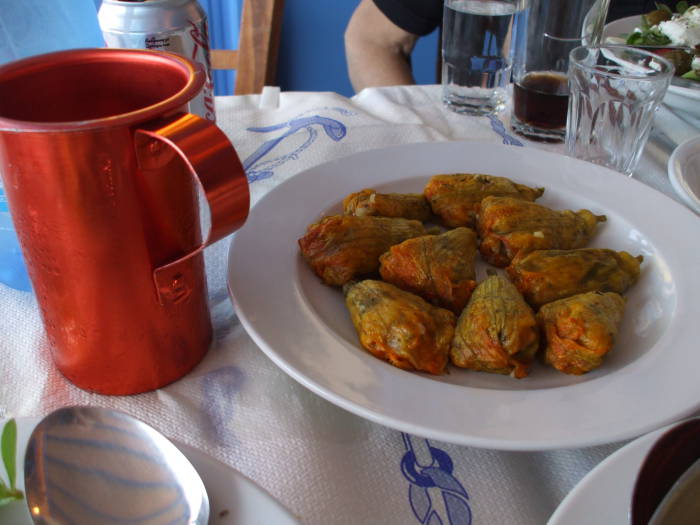
The lentil paste is in the foreground. Behind that is one of those rice stuffed blossoms, cut open.
This feast of small dishes, or really medium sized dishes, was the result of asking our innkeeper where he likes to eat.
He has very good taste.
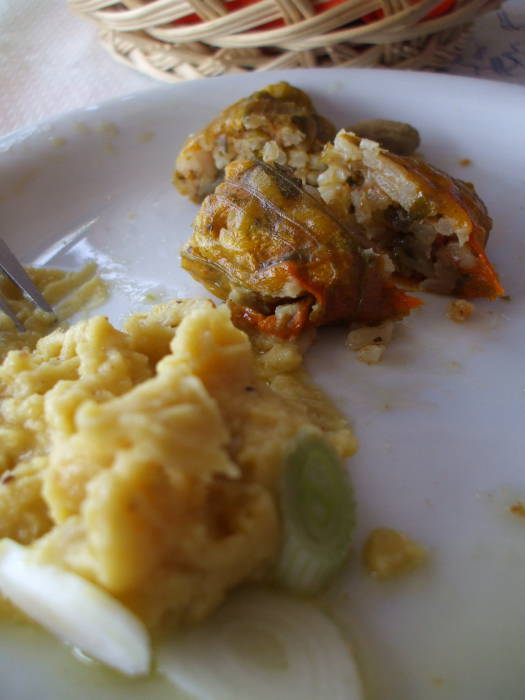
Now we are sitting in a cafe along the edge of the caldera at the center of Santorini, also known as Thira or Thera depending on how you transliterate the real Greek name of Θηρα. "Santorini" is the Italian name the Venetians used when they ruled the Aegean, from the Fourth Crusade's overthrow of Constantinople until the Ottoman Turks took control.
Santorini or Θηρα is the remains of a large volcanic island, the southernmost of the Cyclades island group. It was a conical volcano forming a roughly circular island 15 to 20 kilometers in diameter. The volcano exploded some time around 1600 BC in one of the largest volcanic events in history. It is now estimated that about 100 cubic kilometers of magma and rock were expelled.
The resulting tsunami and ash clouds may have ended the Minoan civilization on Crete. See the Wikipedia articles on Santorini and on the eruption itself for far more details.


The main town of Fira sits on the edge of the caldera, with a nearly sheer drop of 250 to 300 meters down to the water of what is now a large natural harbor.
At left we are looking toward the setting sun (of course), above the gap between the main island and the second largest remaining fragment, Thirasia.
Ferries and cruise ships connecting to destinations to the north of Santorini, which means pretty much everywhere except Crete and some nearby minor islands, enter and leave the caldera through that opening.
It's another meze platter!
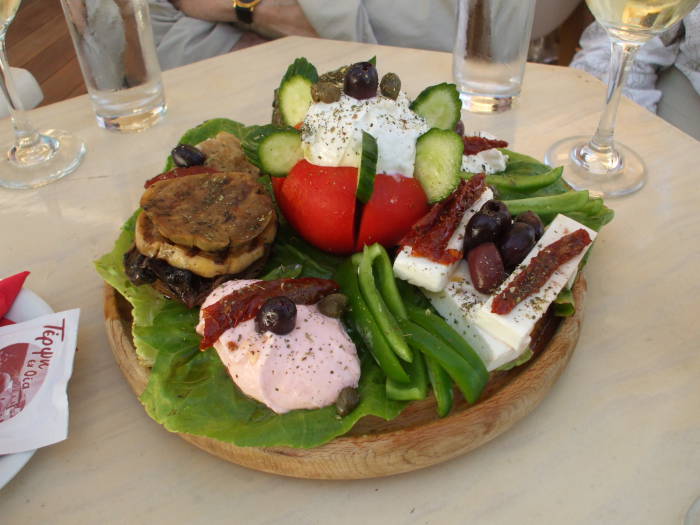
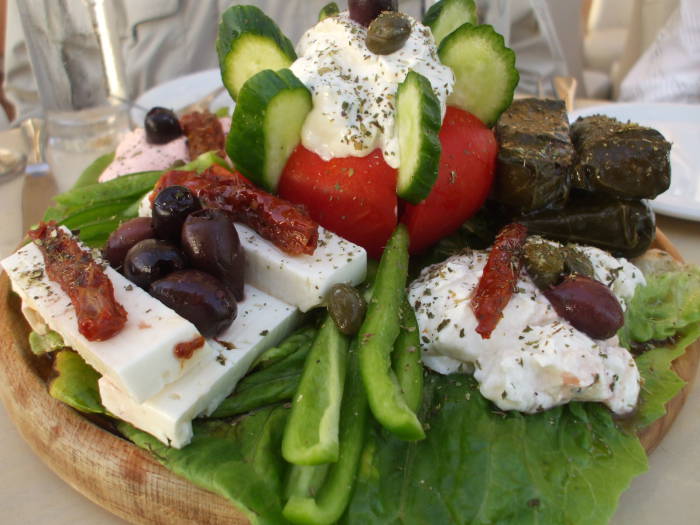
Feta cheese blocks, sliced green bell peppers, cucumbers, and tomatoes, and a large spoonful of tzatziki.
On this side, dolmades, baba ghanoush, and a large steamed mushroom cap.
Baba ghanoush is the Arabic name, I don't know what the Greek name is for a paste of roasted aubergine (or eggplant as Americans call it).


Another sunset, another evening on Santorini, this time at the Lithos cafe. They have spelled their cafe's name with olive oil and sprinkled on herbs. This is a skewer of grilled fish, steamed vegetables, and rice.
The other plate at Lithos: grilled fish steak.
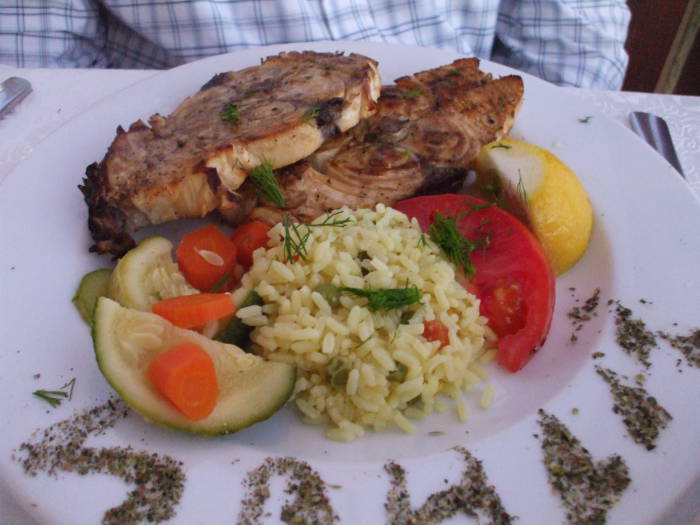

Back to Mykonos for a last pair of pictures. These seats are right on the water in the Venetia or Little Venice area of Mykonos, also taking its name from the time of the Venetian rule of the islands.
Everyone gathers here to watch the sun set. Get there in plenty of time if you want a seat! And be ready to get a few drops of the Aegean on you if you sit right next to the edge.
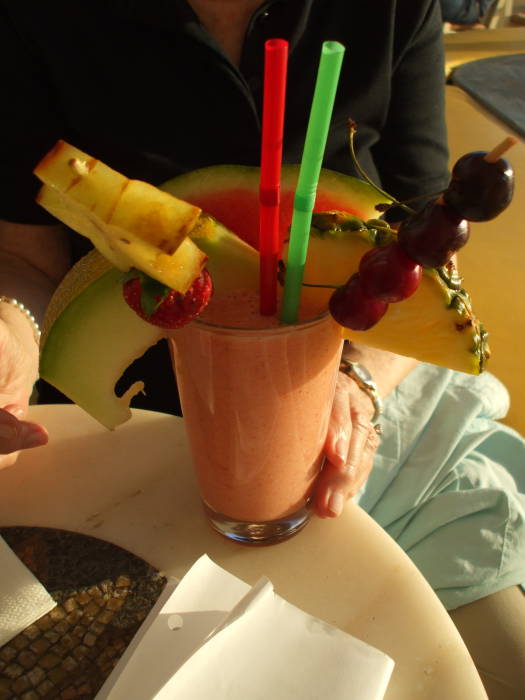
Here's a meal in a glass, a fruit smoothie with a variety of whole fruit on skewers.